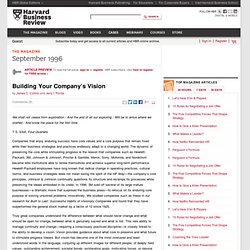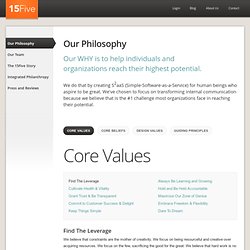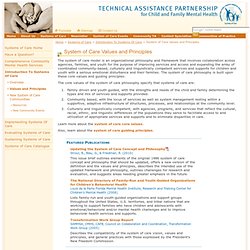

Defining and Implementing Core Values. Building Your Company’s Vision. The Idea in Brief Hewlett-Packard. 3M.

Sony. Companies with exceptionally durable visions that are “built to last.” What distinguishes their visions from most others, those empty muddles that get revised with every passing business fad, but never prompt anything more than a yawn? Enduring companies have clear plans for how they will advance into an uncertain future. The Idea in Practice A company’s practices and strategies should change continually; its core ideology should not. A core ideology has two parts: 1. 2. An envisioned future, the second component of an effective vision, has two elements: 1. 2. Example: In the 1950s, Sony’s goal was to “become the company most known for changing the worldwide poor-quality image of Japanese products.” Don’t confuse your company’s core ideology with its envisioned future—in particular, don’t confuse a BHAG with a core purpose. T.S. Design principles to choose the right ideas – Henk Wijnholds. Monday October 26, 2009 Often people ask me how we know which ideas to choose from all the hundreds of ideas we’ve generated during brainstorm sessions.

Apart from our gut feelings and experience there’s a method that could help us decide, define design principles. In the past we used to call these principles ‘design criteria’ until I came across this great article about ‘Ubiquitous Computing Workshop: Mobile User Experience Design Principles‘ by Rachel Hinman back in 2007. Mission, Vision, Core Values. Mission Statement To provide quality higher education with emphasis on educating the nation’s military and public service communities by offering respected, relevant, accessible and affordable, student-focused online programs, which prepare them for service and leadership in a diverse, global society.

Vision The University System is a respected higher-learning organization known for its distinctive strengths in providing superior and relevant distance learning programs to its learners. In pursuing this vision, the University System: Creates interactive, effective learning environments for all constituents.Serves its constituents’ diverse personal and professional development needs.Expands access to affordable programs to underserved learners.
Philosophy. Find The Leverage We believe that constraints are the mother of creativity.

We focus on being resourceful and creative over acquiring resources. We focus on the few, sacrificing the good for the great. We believe that hard work is no longer a competitive advantage, so given finite time and energy we continually seek to create greater and greater outcomes by finding the leverage in everything we do. One way we Find the Leverage is through our other Core Values of Cultivate Health & Vitality, Keep Things Simple, Always Be Learning and Growing, Maximize Our Zone of Genius, and Dare to Dream. Cultivate Health & Vitality. System of Care Values and Principles. The system of care model is an organizational philosophy and framework that involves collaboration across agencies, families, and youth for the purpose of improving services and access and expanding the array of coordinated community-based, culturally and linguistically competent services and supports for children and youth with a serious emotional disturbance and their families.

The system of care philosophy is built upon these core values and guiding principles: The core values of the system of care philosophy specify that systems of care are: Featured Publications Updating the System of Care Concept and Philosophy (PDF) Stroul, B., Blau, G., & Friedman, R. (2010) The National Directory of Family-Run and Youth-Guided Organizations for Children’s Behavioral Health Louis de la Parte Florida Mental Health Institute, Research and Training Center for Children's Mental Health (2008) Transformation Work Group Report. How Zappos Infuses Culture Using Core Values - Tony Hsieh. By Tony Hsieh | 10:00 AM May 24, 2010 Tony Hsieh is the CEO of Zappos.com, Inc.

During the past 10 years, the company has grown from almost no sales to more than $1 billion in annual gross merchandise sales, driven primarily by repeat customers and word of mouth. Below is an excerpt from Tony’s forthcoming book that describes the beginning of Zappos. Even though our core values guide us in everything we do today, we didn’t actually have any formal core values for the first six or seven years of the company’s history.
It’s my fault that we didn’t do it in the early years, because it was something I’d always thought of as a very “corporate” thing to do. I’m just glad that an employee finally convinced me that it was necessary to come up with core values — essentially, a formalized definition of our culture — in order for us to continue to scale and grow. I only wish we had done it sooner. The commitment part was the most challenging part. Tony Hsieh is the CEO of Zappos.com, Inc. Forecast3_0.